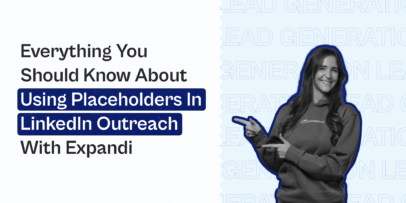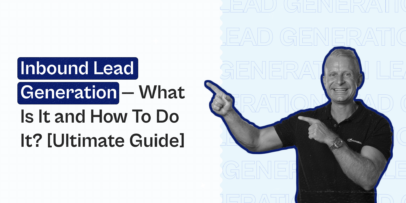Lead Generation Funnel — How To Map Out Your User Journey
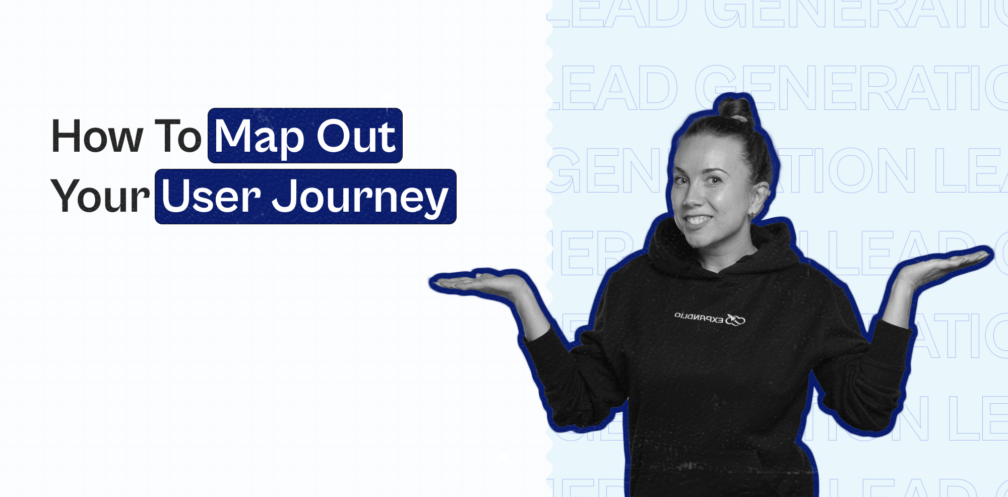
Research from the Aberdeen Group shows that compared to companies without a customer journey management program, companies with such a program:
- Have a Return on Marketing Investment (ROMI) figure that’s 8.7% higher
- Get 4% more positive mentions on social media platforms
- Get 12.8% more revenue from customer referrals
- Make 5.5% more revenue from up-selling and cross-selling
- Improve their sales cycle by 15.9% more
One way to manage your customer journey is through a lead generation funnel.
To help you build an effective funnel, this article will show you how to map out your user journey.
TL;DR:
- A lead generation funnel is a systematic approach to generating leads.
- Customer journey maps catalog the lead generation funnel, helping you optimize your funnel. There are many different types of maps, including current state, future state, and day-in-the-life maps.
- Mapping your journey and building a lead generation funnel involves these steps:
- Defining your audience with an Ideal Customer Profile (ICP).
- Identifying customer pain points, motivations, and goals.
- Mapping user touchpoints and finding roadblocks.
- Crafting a draft of your map.
- Morphing your map into a funnel through strategies like LinkedIn outreach, cold calling, cold emailing, content marketing, social media marketing, and landing pages.
- Evaluating and adjusting your map.
What is a lead generation funnel?
A lead generation funnel is a methodical approach to generating leads.
There are five phases of the funnel:
- Awareness: When leads discover your brand for the first time and learn basic information like what products and services you offer.
- Interest: When leads research your company and offering and learn about your values, history, clients, and the details of your offering (features, pricing, pros, cons, etc.).
- Evaluation: When leads evaluate your offering and compare it to competitors’ offerings.
- Engagement: When leads engage with you via your sales and marketing teams.
- Purchase: When leads buy your offering.
Some companies also observe a sixth phase: loyalty (when customers re-engage).
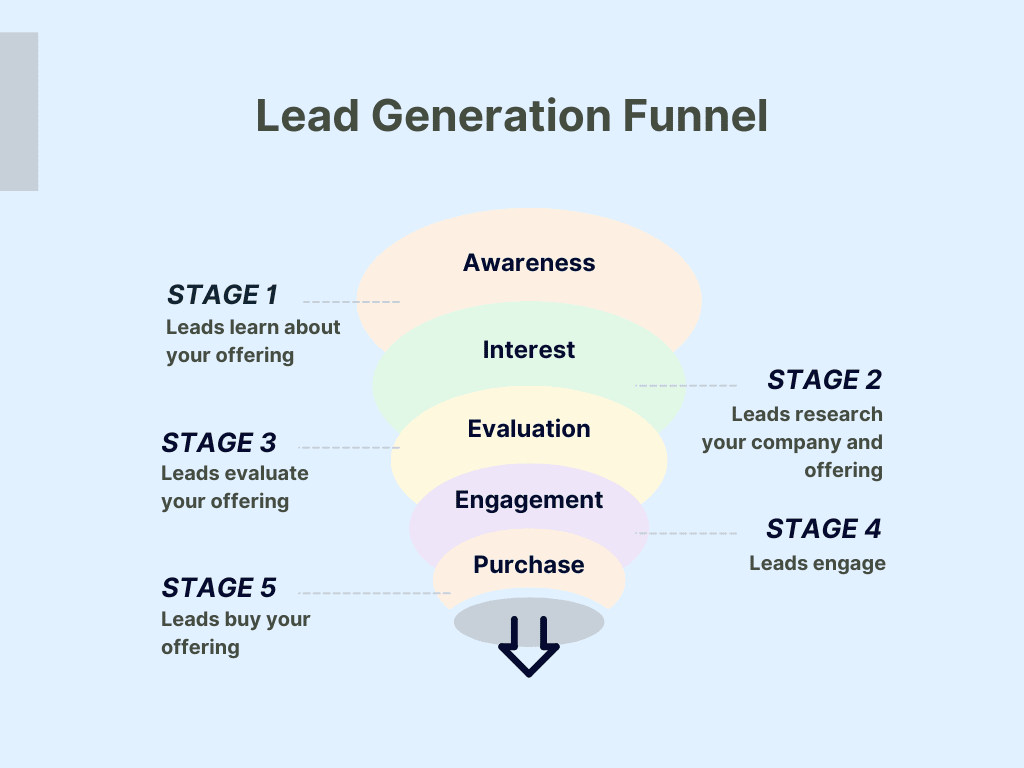
We use the funnel analogy when describing the sales process because you have many leads at the awareness stage — let’s say 100.
As you progress through the interest, evaluation, and engagement stages, some leads leave the funnel — let’s say you are left with 50.
Progressively more leads will leave until you are left with a small group of motivated leads (10 or so) at the purchasing stage who buy your offering and convert to customers.
The funnel analogy is also useful because, like gravity, your sales funnel pushes leads deeper into the funnel.
Note: Learn more about inbound lead generation in our Inbound Marketing Funnel: What It Is and How To Use It For Your Business guide.
Does a lead generation funnel use TOFU, MOFU, or BOFU content?
The phrases “TOFU” (or “Top-of-the-Funnel”), MOFU (or “Middle-of-the-Funnel”), and BOFU (“Bottom-of-the-Funnel”) content are thrown around a lot when discussing lead generation funnels.
And here’s why: funnel content helps you nurture leads.
During the awareness phase, TOFU content helps you bring as much traffic from potential leads to your marketing channels (particularly your website) as possible.
During the interest and evaluation phases, MOFU content teaches prospects why your company and offering are superior to competitors’ offerings.
During the engagement and purchase stages, BOFU content shows leads how your offering helps them reach their goals and where it fits into their work lives.
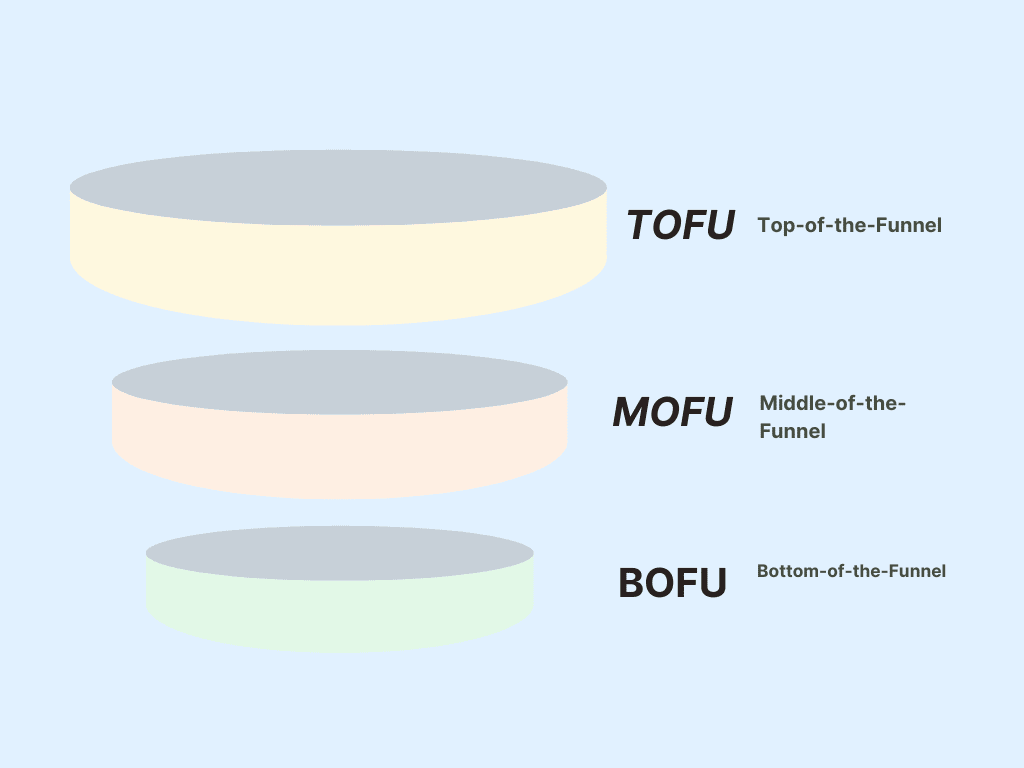
B2B lead generation funnel vs. B2C lead generation funnel
This article focuses on B2B lead generation funnels (though I’ve tried to include insights any marketer can use).
So before we continue, here’s a quick summary of the differences between the Business-to-Business (B2B) and Business-to-Consumer (B2C) lead generation process*:
*Of course, these are generalizations and won’t apply 100% of the time.
- The length of the sales cycle.
The B2B sales cycle is often longer because B2B purchasers need to justify their decision to others, research many potential options thoroughly, and document the process. Multiple people and departments often need to sign off on the purchase (often, this includes higher-ups with very busy schedules).
Many B2B deals are also high ticket, and buyers weigh-up high ticket deals very thoroughly.
- Target audience and relationships.
A B2B company selling accounting software, for example, has a more transactional relationship with customers — customers get access to the software and the brand gets revenue.
A B2C brand selling backpacks, for example, has a more intimate relationship with customers — customers choose a backpack based on their style, desires, experiences, and identity.
Customers don’t grow attached to accounting software the way they do to a backpack that showcases their identity, so their relationship with the backpack brand will be different.
- The type of lead generation channels used.
A B2B company selling web design services would likely use marketing channels that reach purchasers at work — for example, LinkedIn, Paid-Per-Click (PPC) marketing targeting web design-related keywords, cold emailing, Search Engine Optimization (SEO), and cold calling.
A B2C company selling skin and beauty treatments, for example, would be more likely to use influencer marketing, referral marketing, and social media advertising on Facebook and Instagram.
- Pricing strategy.
With B2B customers, the person making the purchasing decision is separate from the entity footing the bill.
Usually, B2B consumers pay for their own purchases (with the notable exception, of course, of products for babies and children).
Lead generation funnels and customer journey maps
I’ve mentioned previously in this article that there is a clear link between customer journey maps (visual storylines of customers’ interactions with your brand) and lead generation funnels. Data supports this link.
Studying the link, AltmanVilandrie & Company surveyed 190 B2B marketing decision-makers from US-based companies with over $100 million in annual revenue. This survey found that mapping the customer journey is associated with a 3–5% higher conversion rate of Marketing Qualified Leads (MQLs) to customers and a 10–17% higher conversion rate of Sales Qualified Leads (SQLs) to customers.
Companies that rigorously map customer journeys are “handsomely rewarded”.
And if you take a look at this chart showing how effective other lead generation and nurturing strategies were in increasing conversions, you’ll see why. Mapping the customer journey map yields a far higher conversion rate.

Types of customer journey maps
Some customer journey maps capture particular perspectives of the user journey. These include:
Current state journey maps
Current state maps capture the user journey as it stands today. It’s a “warts and all” map that captures the good and bad aspects of your funnel.
These maps help sales reps and marketers:
- Communicate user frustrations
- Identify current bottlenecks and pain points
- Rationalize why certain areas of the lead generation process need tweaking
Compared to other types of customer journey maps, current state maps are grounded in data from real users. This data could be:
- Qualitative, describing how users think, feel, and behave. Qualitative data is primarily subjective.
- Quantitative, using data points that are counted or measured (like how many users click a particular button). Quantitative data is primarily objective.
Here’s an example of a current state map from TreasuredData:
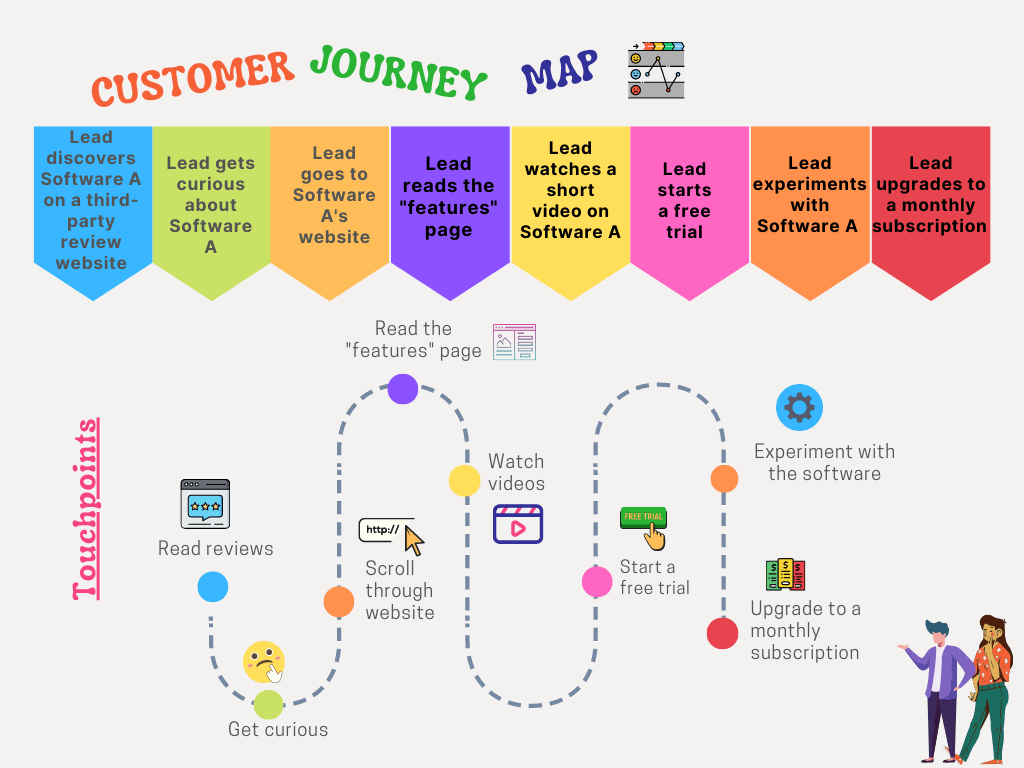
I will show you how to create a current state map later in this article.
Future state journey maps
Future state journey maps capture the best-case scenario for your lead generation funnel. They imagine what could happen if you had unlimited resources, endless time, and full creative freedom.
Future state journey maps help marketers and sales reps:
- Set goals for the lead generation funnel
- Brainstorm solutions to bottlenecks and pain points creatively
- Compare the state of the funnel to the goals for it (assuming they have already created a current state journey map)
- Explain issues with the current sales funnel to other internal stakeholders (like higher-ups)
Future state maps should draw inspiration from data but aren’t bound by it.
Day-in-the-life journey maps
Day-in-the-life maps showcase where an average user’s journey fits into their overall daily life. They often break the journey down into segments of 1–3 hours.
Day-in-the-life maps help sales reps and marketers:
- Step back and visualize where an offering fits into an average user’s day
- Understand the other stressors in a user’s life that influence how they interact with the offering
- Learn what product features are most and least important to users
Some day-in-the-life maps are based on market research performed on a single user, while other maps are fictional but draw inspiration from many users.
Here’s an example of a day-in-the-life map:
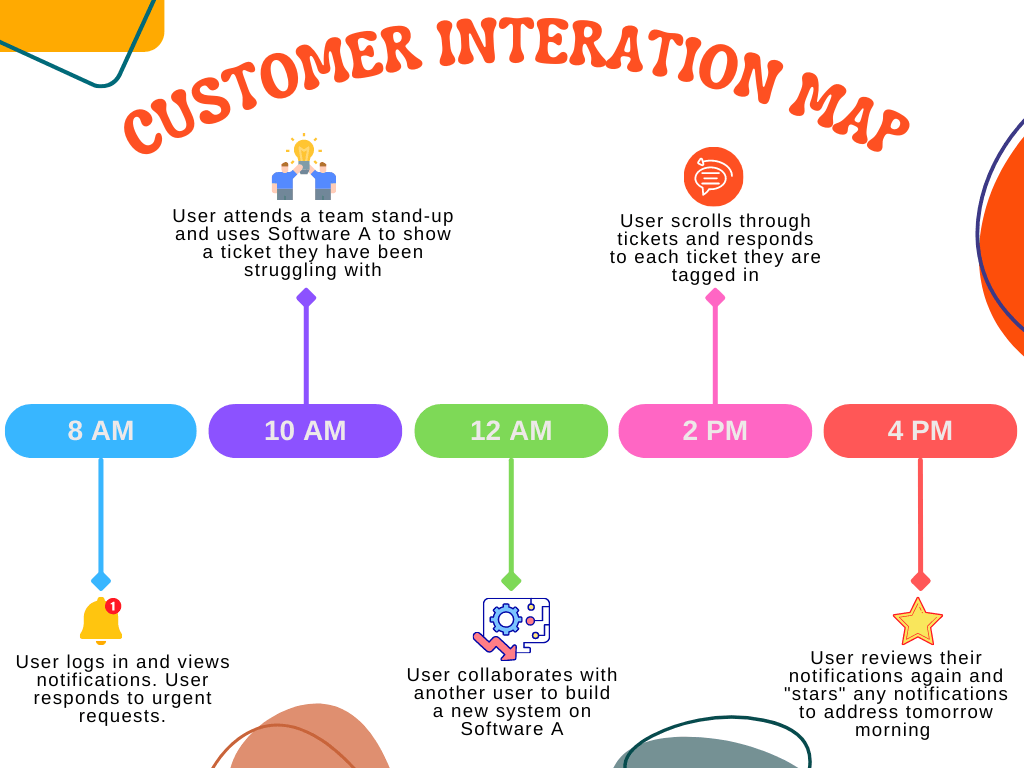
How to map out your users’ journey and build a lead generation funnel
Ready to learn how to create a current state map? Read on…
Step 1. Define your target audience with an Ideal Customer Profile (ICP)
First, you’ll need to develop an Ideal Customer Profile (ICP) — a thorough description of the characteristics that make your perfect target audience identifiable.
Here are some characteristics your ICP should include:
- Demographic information like age range and gender.
- Professional information like job title, position description, daily work priorities, industry, and niche.
- Geographical information like country of residence, languages spoken, and city/town of residence.
- Customer information like pain points, daily frustrations, motivations, goals, and challenges.
- Company information like the number of employees, whether it’s public or private, revenue, growth rate, and industry segment.
Step 2. Identify your users’ pain points and goals
Next, expand on users’ pain points and goals, so you can dive into what drives your customers throughout their journey in your lead generation funnel.
There are four types of pain points:
- Productivity pain points.
These are pain points that influence the workplace productivity of users.
For example, part of Sally’s job as a sales rep is LinkedIn outreach. This requires her to write and send 50+ outreach messages daily — taking 4–5 hours of her work day.
- Financial pain points.
These are pain points related to how much the customer spends on their current solution.
For example, Matt’s company spends 25% of its monthly revenue on accounting services. This is financially unsustainable.
- Process pain points.
These are pain points related to internal processes with current systems.
For example, Janes’ email outreach tool can’t handle PDFs. So, when she needs to send PDF flyers to customers (a daily part of her job), she must open her email in a separate window and upload the PDF manually.
- Support pain points.
These are pain points caused by users not receiving the support they need, costing them time.
For example, Joe can’t remember the password for his Customer Relationship Management (CRM) tool, but there is no “forgot password” button. He must contact support, but they are only open from 10 am to 3 pm.
Once you’ve expanded your user pain points, re-frame them as goals. For example:
- Sally’s goal is to find a LinkedIn outreach tool with automation (like Expandi).
- Matt’s goal is to find an accounting tool that costs 2.5% of the company’s revenue.
- Jane’s goal is to find an email outreach tool that can handle PDFs.
- Joe’s goal is to find a CRM tool with more robust support.
Step 3. Map out users’ touchpoints and identify roadblocks and bottlenecks
Next, identify all the major touchpoints inside your lead generation funnel. Here are some touchpoints to consider:
- Landing pages
- Lead magnets
- Social media pages
- PPC ads
- Cold emails
- Cold calls
- Blog posts
- Videos
Put yourself in users’ shoes and find a path from one touchpoint to another. For example, you might go from a PPC ad to a particular landing page to the “features” webpage to the “free trial” webpage.
With these touchpoints in place, turn your attention to roadblocks and bottlenecks.
Roadblocks are factors that stop users from completing the desired action at all. For example, if your “start free trial” button didn’t work.
Bottlenecks are factors that make it harder for users to complete the desired action. For example, if your email marketing Call To Action (CTA) didn’t link to your website and users had to navigate there manually.
Step 4. Finalize your map
Take the path between touchpoints from the previous step and sketch a draft of your customer journey map.
When doing this, it’s helpful to remember that every action has a “why”:
- Why do customers engage with this touchpoint?
- Why are customers continuing their journey?
- Why aren’t customers getting distracted?
Once you’ve got a rough sketch, revisit your ICP, pain points, motivations, roadblocks, and bottlenecks, and ensure they are accounted for.
Then, run your map past other stakeholders and request feedback. They’ll likely spot things you missed.
Step 5. Turn your map into a funnel
Now, take the insights from your map and transform your touchpoints into strategic lead conversion tools.
Of course, this will look different for every brand, so I can’t advise you on what strategies will 100% work. Instead, here are some general strategies:
- Developing lead magnets.
Lead magnets are a clever way to get contact details from customers while providing them with a valuable resource that pushes them deeper into your sales funnel.
Lead magnets can be anything from a downloadable podcast to a PDF or a worksheet. Adding urgency, such as promoting an exclusive limited time offer, can dramatically increase sign‑ups and push leads further down the funnel.
- Cold emailing.
Automation-driven cold emailing is a fast and efficient outreach tactic. It connects you with new leads quickly, making it an affordable and scalable strategy.
- Cold calling.
Cold calling is less efficient than cold emailing, but it’s still a great way to make a connection. It has the added bonus of a personal touch, as there’s something irreplaceable about person-to-person calls.
Read: Cold Email vs. Cold Call: Which is More Effective?
- LinkedIn outreach.
LinkedIn outreach is the #1 channel for B2B marketers to distribute content. LinkedIn has 850 million members from 200 countries, and 80% of B2B marketing leads from social media come from LinkedIn.
- Content marketing.
Content marketing is fantastic for increasing brand awareness, and it’s a strategy employed by 97% of organizations. 41% of companies will increase their content marketing budgets in 2024.
It’s no wonder the content marketing industry was worth $63 billion in 2022.
- An omnichannel approach.
Omnichannel is when you provide a seamless experience that spans multiple marketing channels.
For example, our Hyper-personalized Omnichannel Growth Hack to Follow post outlines a strategy in which you:
- Create an offer your target market will love and post about it on LinkedIn.
- Endorse the post via Lempod.
- Create an Expandi campaign to connect with post commenters.
- Create two outreach campaigns (one with the offer and one with a follow-up message) on Lemlist.
- Weave everything together with Zapier.
Step 6. Evaluate and adjust
Finally, it’s time to evaluate your map and adjust it, so it aligns with your actual lead generation funnel.
The number one thing to look for is areas where your map doesn’t align with users’ real experiences. If you can, consult with a handful of users and ask for customer feedback. They know their journey better than anyone else.
Is that it? Not quite!
Here are some red flags to look for during the evaluation process:
- Unnecessary or unnatural paths between touchpoints
- Gaps between your customer data and ICP and map
- Areas of friction
- Areas that lack detail and actionability
If you find any areas where your map is lacking, go back and adjust it now.
You should also make it a practice to consult your map and adjust it regularly. Your customer journey will change as your customers evolve. After all, no one would have included TikTok in their map five years ago, but as of 2021, 12% of B2B marketers get the most Return on Investment (ROI) from it.
Final thoughts: Lead generation funnels and user journeys
Mapping your user journeys will transform your lead generation funnels, leading to:
- Better ROI
- More conversions
- More efficiency
- Increased customer satisfaction
We mentioned many actionable strategies you can try when transforming your funnel, including LinkedIn outreach.
If you’re serious about LinkedIn outreach, try Expandi.
Expandi helps you set up automated outreach campaigns that work. You can set Expandi up in 15 minutes and get results in 24 hours.
You’ve made it all the way down here, take the final step

